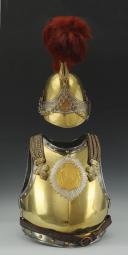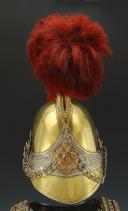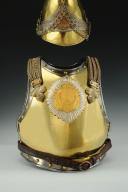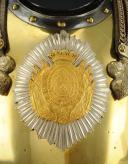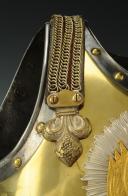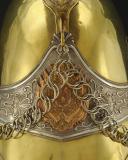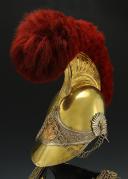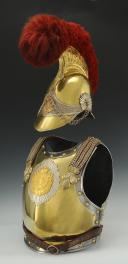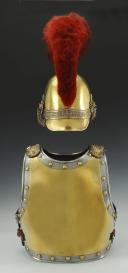
OFFICER HELMET AND BREASTPLATE OF CARABINIERS OF MONSIEUR, model 1817-1818, Restoration period. 26597/14463.
Sold out
OFFICER HELMET AND CUIRASS OF THE CARABINIERS OF MONSIEUR, model 1817-1818, Restoration. 26597/14463
Helmet in gilded brass following the design of the helmets of the First Empire. High bomb strongly rejected backwards in the "Minerva" style, a shape that disappeared a few years later, around 1820. Crest, stamped on the flaps with a decreasing series of nine godrons emerging from tulips and separated by acanthus leaves, mask decorated at its lower part with two branches of laurel. Front band in silver, embossed with relief foliage motifs, decorated in its center with a gilded copper badge stamped with the arms of Monsieur: the arms of France on a background of a bundle of flags topped with Monsieur’s crown. At the top in the center, the band forms a rosette with a hook for fastening the chin strap when worn upright. Back band in silver similarly decorated as the front. Visor and neck guard in gilded brass, encircled with a thin silvered brass wire folded over their outer edges. Free-jawed chinstrap, composed of a sunburst-shaped rosette decorated in its center with a gilded brass fleur-de-lis bearing a hook in the center to fasten the chin strap, and a chin strap made of a chain bracelet in silver. Scarlet wool plume. Inner leather liner cut into nine wolf teeth.
Very good overall condition, gilt on the bandeau badge rubbed on the reliefs, missing crimson cloth lining of the chin strap, rubbed leather on the inner liner.
Cuirass, identical to the First Empire model, is a combat model with a mounted troop base at the time with officer trims. It is composed of two parts: a breastplate and a backplate, both made of iron covered with a thick sheet of brass attached with rivets; these brass plates do not cover the entire cuirass, as the edges of each part are without brass but lined with brass rivets, round-headed; on the outside, the steel forms a rim, except at the neck where the metal is folded outwards. The breastplate is rounded with a slight center ridge. The backplate is attached to the breastplate by two leather epaulettes lined with crimson cloth trimmed with silver braids, which are covered with three brass chains and end with a large gilded brass fleur-de-lis, with a hole at the back for attachment to protruding rivets fixed on the breastplate. The breastplate is adorned with a large silver sunburst "glory" in the center, with a gilded brass plate depicting the arms of Monsieur fixed at the center. Leather belt wrapped in burgundy Morocco leather covered with a wide silver braid with a silvered brass buckle.
Accident on the belt, torn on both parts and sewn back together. Tears and wear on the leather at the upper part of the straps. Otherwise, very good condition.
Historical Background:
Monsieur: Charles Philippe of France is the last son of Louis the Dauphin and Marie Josephe of Saxony, the last of the five grandsons of Louis XV. At his birth in 1757, he received the title of Count of Artois. He was made a Knight of the Order of the Golden Fleece in 1761 and received the King's Orders: Saint Michael and the Holy Spirit in 1771. He was Colonel General of the Swiss and Grisons. In 1789, the Count of Artois emigrated. When the Dauphin, Louis XVI's son, died in the Temple prison in Paris in 1795, Louis Stanislas Xavier, Count of Provence, the younger brother of Louis XVI, took the name Louis XVIII (Louis XVI's son having been given the title Louis XVII by the legitimists upon his father's death in 1793) and became King in 1814. Since the death of Louis XVI, the Count of Artois took the title of Monsieur, and he became King upon his brother Louis XVIII's death, becoming Charles X.
The Count of Artois adopted arms different from the old arms of Artois, which read "of France with a crenellated gules border" (meaning that the border surrounding the escutcheon is notched), with the crown of the Princes of the Blood above them, surrounded by the three collars of the chivalric orders he had received. The arms are supported by eight flags for the position of Colonel General of the Swiss.
COLLECTIBLE ITEM:
The helmet presented here is with its very rare chain chin strap adopted in 1817, and as far as our knowledge goes, it is the only surviving example of a carabinier with this feature. All other helmets quickly switched to scale chin straps. This helmet is identical to the First Empire helmet except for the arms of the Count of Artois which replaced the N symbol and the imperial crown.
THE REGIMENT:
Originally created in 1693, the Carabiniers of Monsieur were initially known as Royal Carabiniers, then renamed Carabiniers of Monsieur le Comte de Provence in 1758, before assuming the name Carabiniers of Monsieur in 1774. Disbanded after the fall of the Empire, the two Carabinier regiments were merged into a single brigade on May 12, 1814, under the name "Corps of the Carabiniers of Monsieur," and then reduced to 4 squadrons of two companies each on August 30, 1815, totaling 44 officers and 538 men. It took ten years, until February 27, 1825, for the Carabiniers to be reorganized into two regiments of 6 squadrons each. Under the Second Empire, the Carabiniers were merged into a single regiment belonging to the Imperial Guard and did not survive the defeat of 1870, at which point the carabiniers disappeared, forming the 11th Cuirassiers Regiment from 1871 onward.
Helmet in gilded brass following the design of the helmets of the First Empire. High bomb strongly rejected backwards in the "Minerva" style, a shape that disappeared a few years later, around 1820. Crest, stamped on the flaps with a decreasing series of nine godrons emerging from tulips and separated by acanthus leaves, mask decorated at its lower part with two branches of laurel. Front band in silver, embossed with relief foliage motifs, decorated in its center with a gilded copper badge stamped with the arms of Monsieur: the arms of France on a background of a bundle of flags topped with Monsieur’s crown. At the top in the center, the band forms a rosette with a hook for fastening the chin strap when worn upright. Back band in silver similarly decorated as the front. Visor and neck guard in gilded brass, encircled with a thin silvered brass wire folded over their outer edges. Free-jawed chinstrap, composed of a sunburst-shaped rosette decorated in its center with a gilded brass fleur-de-lis bearing a hook in the center to fasten the chin strap, and a chin strap made of a chain bracelet in silver. Scarlet wool plume. Inner leather liner cut into nine wolf teeth.
Very good overall condition, gilt on the bandeau badge rubbed on the reliefs, missing crimson cloth lining of the chin strap, rubbed leather on the inner liner.
Cuirass, identical to the First Empire model, is a combat model with a mounted troop base at the time with officer trims. It is composed of two parts: a breastplate and a backplate, both made of iron covered with a thick sheet of brass attached with rivets; these brass plates do not cover the entire cuirass, as the edges of each part are without brass but lined with brass rivets, round-headed; on the outside, the steel forms a rim, except at the neck where the metal is folded outwards. The breastplate is rounded with a slight center ridge. The backplate is attached to the breastplate by two leather epaulettes lined with crimson cloth trimmed with silver braids, which are covered with three brass chains and end with a large gilded brass fleur-de-lis, with a hole at the back for attachment to protruding rivets fixed on the breastplate. The breastplate is adorned with a large silver sunburst "glory" in the center, with a gilded brass plate depicting the arms of Monsieur fixed at the center. Leather belt wrapped in burgundy Morocco leather covered with a wide silver braid with a silvered brass buckle.
Accident on the belt, torn on both parts and sewn back together. Tears and wear on the leather at the upper part of the straps. Otherwise, very good condition.
Historical Background:
Monsieur: Charles Philippe of France is the last son of Louis the Dauphin and Marie Josephe of Saxony, the last of the five grandsons of Louis XV. At his birth in 1757, he received the title of Count of Artois. He was made a Knight of the Order of the Golden Fleece in 1761 and received the King's Orders: Saint Michael and the Holy Spirit in 1771. He was Colonel General of the Swiss and Grisons. In 1789, the Count of Artois emigrated. When the Dauphin, Louis XVI's son, died in the Temple prison in Paris in 1795, Louis Stanislas Xavier, Count of Provence, the younger brother of Louis XVI, took the name Louis XVIII (Louis XVI's son having been given the title Louis XVII by the legitimists upon his father's death in 1793) and became King in 1814. Since the death of Louis XVI, the Count of Artois took the title of Monsieur, and he became King upon his brother Louis XVIII's death, becoming Charles X.
The Count of Artois adopted arms different from the old arms of Artois, which read "of France with a crenellated gules border" (meaning that the border surrounding the escutcheon is notched), with the crown of the Princes of the Blood above them, surrounded by the three collars of the chivalric orders he had received. The arms are supported by eight flags for the position of Colonel General of the Swiss.
COLLECTIBLE ITEM:
The helmet presented here is with its very rare chain chin strap adopted in 1817, and as far as our knowledge goes, it is the only surviving example of a carabinier with this feature. All other helmets quickly switched to scale chin straps. This helmet is identical to the First Empire helmet except for the arms of the Count of Artois which replaced the N symbol and the imperial crown.
THE REGIMENT:
Originally created in 1693, the Carabiniers of Monsieur were initially known as Royal Carabiniers, then renamed Carabiniers of Monsieur le Comte de Provence in 1758, before assuming the name Carabiniers of Monsieur in 1774. Disbanded after the fall of the Empire, the two Carabinier regiments were merged into a single brigade on May 12, 1814, under the name "Corps of the Carabiniers of Monsieur," and then reduced to 4 squadrons of two companies each on August 30, 1815, totaling 44 officers and 538 men. It took ten years, until February 27, 1825, for the Carabiniers to be reorganized into two regiments of 6 squadrons each. Under the Second Empire, the Carabiniers were merged into a single regiment belonging to the Imperial Guard and did not survive the defeat of 1870, at which point the carabiniers disappeared, forming the 11th Cuirassiers Regiment from 1871 onward.
Reference :
26597/14463
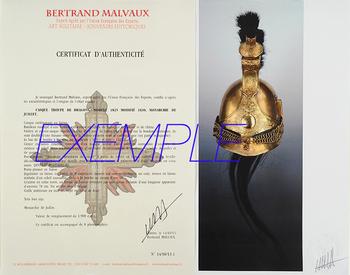
Next update Friday, october 31 at 13:30 PM
FOR ALL PURCHASES, PAYMENT IN MULTIPLE CHECKS POSSIBLE
bertrand.malvaux@wanadoo.fr 06 07 75 74 63
SHIPPING COSTS
Shipping costs are calculated only once per order for one or more items, all shipments are sent via registered mail, as this is the only way to have proof of dispatch and receipt.
For parcels whose value cannot be insured by the Post, shipments are entrusted to DHL or Fedex with real value insured, the service is of high quality but the cost is higher.
RETURN POLICY
Items can be returned within 8 days of receipt. They must be returned by registered mail at the sender's expense, in their original packaging, and in their original condition.
AUTHENTICITY
The selection of items offered on this site allows me to guarantee the authenticity of each piece described here, all items offered are guaranteed to be period and authentic, unless otherwise noted or restricted in the description.
An authenticity certificate of the item including the description published on the site, the period, the sale price, accompanied by one or more color photographs is automatically provided for any item priced over 130 euros. Below this price, each certificate is charged 5 euros.
Only items sold by me are subject to an authenticity certificate, I do not provide any expert reports for items sold by third parties (colleagues or collectors).
FOR ALL PURCHASES, PAYMENT IN MULTIPLE CHECKS POSSIBLE
bertrand.malvaux@wanadoo.fr 06 07 75 74 63
An authenticity certificate of the item including the description published on the site, the period, the sale price, accompanied by one or more color photographs is automatically provided for any item priced over 130 euros. Below this price, each certificate is charged 5 euros.
Only items sold by me are subject to an authenticity certificate, I do not provide any expert reports for items sold by third parties (colleagues or collectors).
